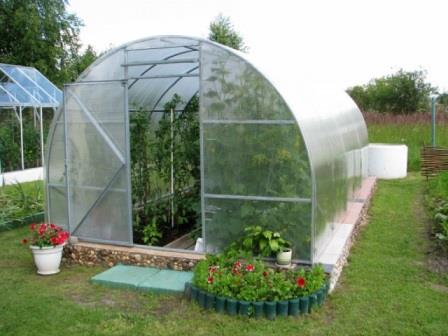 If you are thinking about how to feed seedlings of cucumbers after planting in a greenhouse, consider the tips of experienced gardeners. It is necessary to start fertilizing cucumbers from seedlings. When a couple of real leaves appeared on a young plant, it means that its root system has grown stronger and it's time to make the first feeding. It should be taken very seriously, because right now the future bush is being formed, and the whole further crop depends on it. On sale there is a whole arsenal of all kinds of complex fertilizers for seedlings of cucumbers. It is quite simple to apply such fertilizers, the main thing is to familiarize yourself with the instructions that are on each package.
If you are thinking about how to feed seedlings of cucumbers after planting in a greenhouse, consider the tips of experienced gardeners. It is necessary to start fertilizing cucumbers from seedlings. When a couple of real leaves appeared on a young plant, it means that its root system has grown stronger and it's time to make the first feeding. It should be taken very seriously, because right now the future bush is being formed, and the whole further crop depends on it. On sale there is a whole arsenal of all kinds of complex fertilizers for seedlings of cucumbers. It is quite simple to apply such fertilizers, the main thing is to familiarize yourself with the instructions that are on each package.
Read more: diseases of cucumbers in the greenhouse and their treatment photo.
Many summer residents, with many years of experience growing greenhouse cucumbers, know that in order to get tasty fruits, the soil must be saturated with potassium. Therefore, even during digging, they bring it into the ground, especially when it comes to floodplain soil. Potassium sulfate strengthens the immunity of the plant, increases productivity and helps fight various diseases.
There is no summer cottage or garden where cucumbers are not grown. Each applies his own method of growing and feeding, learns from his own mistakes, asks for advice from friends and acquaintances. But there are some rules that you must adhere to, especially if this vegetable grows in a greenhouse, after a transplant, it requires special attention and knowledge.
Content
Fertilizing and varieties of fertilizers
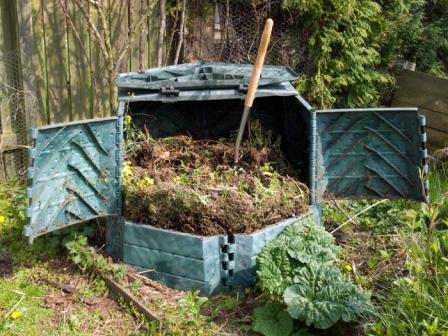
To make fertilizers or not, the choice is left to the gardener. But if we are talking about growing a fetus in a greenhouse, then you can not do without dressing. There are three main fertilizers that are used for greenhouse cucumbers.
Phosphate fertilizer
Correctly and on time phosphorus added will help the plant strengthen the root system, contribute to the proper setting of fruits and their ripening.
Nitrogen Fertilizers
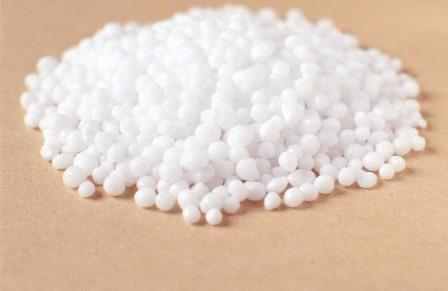
Cucumbers growing in greenhouses are fed with nitrogen fertilizers for almost the entire season. This can be spraying, foliar top dressing or drip irrigation.
Potash fertilizer
Important for normal growth and good fruiting. Many often use potassium chloride, but, nevertheless, it is better to use fertilizers without chlorine, which does not very well affect the fruits of cucumbers. It is better to make it in the fall, when there is a digging of the earth.
But many summer residents recommend using unique remedywhich perfectly fertilizes the soil and helps all plants to grow much sooner.
Feeding cucumbers in a polycarbonate greenhouse
In order for the harvest to be successful, the fruits are beautiful and crisp, even in the fall they begin to prepare the soil. When the entire crop is harvested, thoroughly clean all the garbage in the greenhouse and dig up all the soil, add rotted manure or humus, based on one bucket per 1 square meter.
The decontamination of the structure is also mandatory. The entire greenhouse is treated with a chlorine solution. The mixture is easy to prepare yourself: on a ten-liter bucket take 300 g of the most common bleach. Bred and insisted for several hours. Then spray the room.
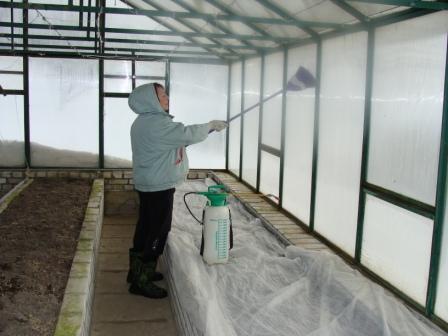
In the spring, the soil is again dug up, watered with warm water, some add a small amount of potassium permanganate. The soil is covered with film and removed before landing.Basically, the nutrition of cucumbers consists of mineral and organic fertilizers, the methods can be either root or extra root.
Throughout the growth, the vegetable needs to be fed. So, in the first stage, he needs primarily nitrogen, then potassium, and during the bearing of phosphorus.
Read more: growing tomatoes according to the method of I.M. Maslova.
Seed selection
An important role in obtaining a high-quality and rich crop is played by the selection of seeds. Seeds should be of high quality, without a single flaw, the best choice is self-pollinating varieties, because there are no bees in the greenhouse. Before planting the seeds in the soil, they must be soaked in a manganese solution, and kept for several days in a damp soft tissue or marlage. As soon as the sprouts appear, the seeds are ready for planting.
How to feed cucumbers in a greenhouse 2 weeks after planting
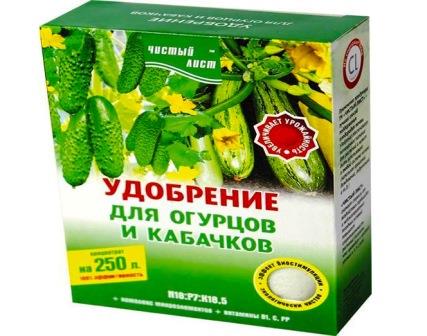
Seedlings are transplanted into the greenhouse, allowed to strengthen, and adapt to a new place. After two weeks, the vegetable is fed with the same fertilizers that were used for seedlings. In order not to burn the roots of a young plant, before feeding it, it is abundantly watered, it is best to do this in the evening.
Many feed seedlings with homemade fertilizers. For this, 10-15 g of superphosphate, in the same amount ammonium nitrate and potassium sulfate, are taken on a ten-liter bucket of warm water. All thoroughly mixed and watered bushes, at the rate of three liters per square meter.
Cucumbers after planting can and even recommended to fertilize with yeast. Once in the ground, they secrete vitamins and phytohormones. Such top dressing is equal to a good complex fertilizer. But, the main thing is not to overdo it, an excess of yeast can lead to active growth of tops, which will slow down the growth and number of fruits.
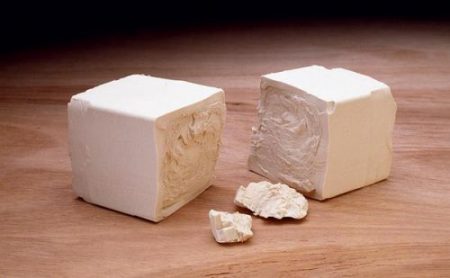
During flowering and fruiting, root and leaf dressing is necessary. This will give the plant the necessary components, protect it from pests and diseases.
A second top dressing is desirable at the beginning of flowering. To help the cucumbers grow and bear fruit, the same fertilizer is applied to the soil, which was used during the first feeding. During this period, the plant, in addition to nitrogen and potassium, also needs magnesium. To do this, add chicken droppings or mullein to the soil.
For the third top dressing, use 10 g of potassium nitrate diluted in 10 liters of water.
During abundant fruiting, the plant needs potash and nitrogen fertilizers. During this period, fertilizing with urea, which is diluted in water, is suitable at the rate of 100 g per 20 liters of water. Many use mullein diluted in water (1: 5). You can buy ready-made drugs, such as: “Zircon”, “Ideal”, “breadwinner”, which will help your plant give good strong fruits. You can also use baking soda (25-30 g of powder per 10 liters).
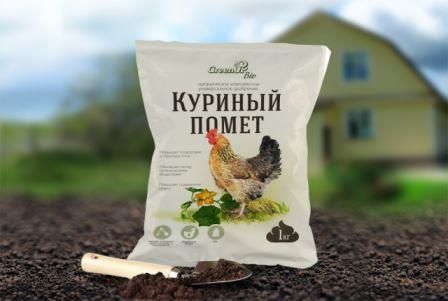
Over the entire season, cucumbers need feeding 3-4 times, but they need to be added in small quantities. It is better not to feed this plant than to overfeed, and the most acceptable option for feeding is aqueous solutions that are better absorbed by the plant.
Read more: growing cucumbers in the open field in the suburbs.
In order to get a good crop of greenhouse cucumbers, you need to remember when feeding is needed:
- the first feeding is recommended after 2 weeks of seedlings in the greenhouse;
- after the first flowering;
- with massive fruiting.
Observing this rule, even the most inexperienced and novice gardener will be able to get high-quality fruits.
Soil for cucumbers
Still need to consider the composition of the earth. For example, clay soil will not give phosphorus and nitrogen to the plant, while sandy soil will lack potassium, boron and copper. Therefore, it is necessary, first of all, to take care of the soil that will be used in the greenhouse.The ideal soil for growing cucumbers is soil, in which ash and charcoal are added.
Fertilizing cucumbers in the greenhouse, what fertilizers are needed
When the cucumbers are beautifully even in shape, the color is green, without yellowing and bending, the leaves are bright green, without spots and do not turn yellow, this indicates that your seedlings are healthy and they are not disturbed by pests and diseases.
If there are not enough cucumbers, or vice versa too many, of any nutrients, you will immediately understand this. To understand what a plant needs or gets in excess, some external factors will help.
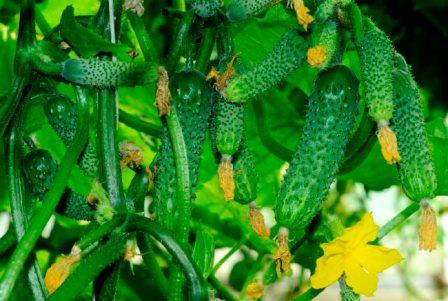
Potassium deficiency
To understand that a vegetable lacks potassium, these simple things will help:
- the leaves became dark green;
- lashes and leaves grow too fast and reach unusual sizes;
- the fruit takes the form of a pear;
- a yellow border appeared on the lower leaves.
- To avoid unwanted results, it is necessary to immediately produce root dressing with a solution of wood ash: just weigh 100 g and dilute in a bucket of water. With this solution, you can fertilize and feed the cucumbers in any period with an interval of ten days.
Lack of nitrogen in the soil:
- light green fruits;
- the fruit resembles a bird's beak or hook;
- stem growth slows down;
- the lower leaves turn yellow.
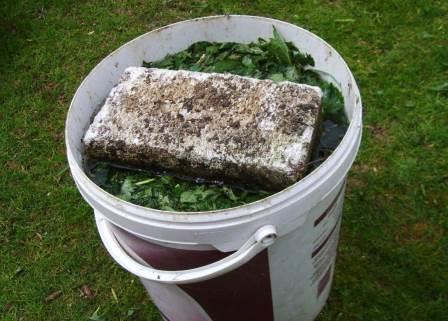
These symptoms can occur due to insufficient watering, and when the plant does not receive enough nitrogen. If this happened during fruiting, then it is better not to resort to chemicals. Feeding can be done with herbal infusion. To prepare such an infusion, about two kilograms of weed grass is cut, finely chopped and poured with a bucket of water per 10 liters. Insist for several days, filter, and use for watering.
Read more: cucumbers in a barrel, growing Ganichkina.
Lack of phosphorus in the soil:
- leaves and shoots slow growth;
- the resulting new leaves are much smaller than the old, they are dark in color and quickly dry out.
To help the plant avoid phosphorus deficiency, such solutions as ammophos and diammophos will help. If the cucumber has a very narrow middle part, this indicates that the water used is too cold, the soil does not have enough magnesium or iron. Complex fertilizers are needed here.
When the fruit begins to be bitter - it is sorely lacking in water; watering needs to be increased. It is necessary to water only with standing water, since tap water, due to various impurities, can adversely affect the plant.
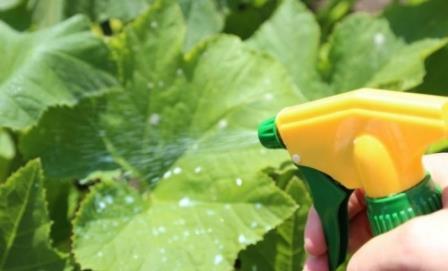
It is best to spray cucumber bushes in the evening or on a cloudy day. The solution should be sprayed well evenly, in small droplets. Thus, he will be able to hold out more time on the surface of the sheets, thereby the plant will have time to absorb all the nutrients.
And if the vegetable begins to turn yellow, then you need to immediately carry out foliar top dressing. In this case, an infusion of fresh nettles can help. A liter of infused grass is bred in a bucket of water and sprayed with bushes.
We told you what fertilizers are needed for cucumbers, a good harvest for you!
Read more: planting cucumbers in 5 liter bottles.




 Armenian cucumber with melon flavor: description and characteristics, reviews
Armenian cucumber with melon flavor: description and characteristics, reviews Do-it-yourself vertical beds for cucumbers: schemes, photos
Do-it-yourself vertical beds for cucumbers: schemes, photos Hollow cucumbers: reasons for the appearance of hollow, what to do
Hollow cucumbers: reasons for the appearance of hollow, what to do Which manure is best for cucumbers: application, how to breed
Which manure is best for cucumbers: application, how to breed